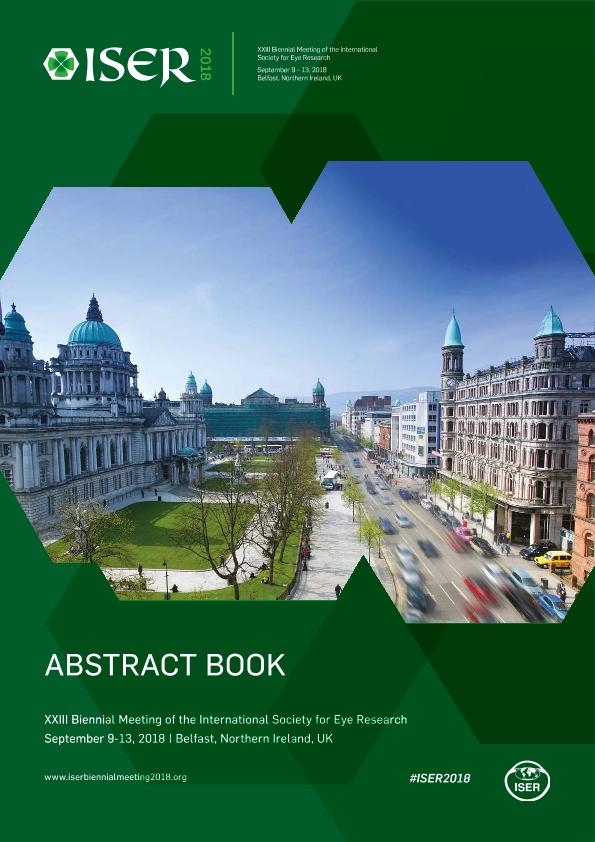Evento
Peptides Derived from PEDF Prevent Apoptosis and Promote Apical Localization of Rhodopsin in Retina Photoreceptors
Tipo del evento:
Congreso
Nombre del evento:
The XXIII Biennial Meeting of the International Society for Eye Research
Fecha del evento:
09/09/2018
Institución Organizadora:
International Society for Eye Research;
Título del Libro:
ISER 2018. The XXIII Biennial Meeting of the International Society for Eye Research
Editorial:
International Society for Eye Research
Idioma:
Inglés
Clasificación temática:
Resumen
Small fragments from pigment epithelium-derived factor (PEDF), 44-mer and 17-mer, exhibit cytoprotective activity on photoreceptors and an R28 retinal progenitor cell line. They act by interacting with PEDF receptor (PEDF-R), a phospholipase encoded by the PNPLA2 gene. Recently, we found that PEDF prevents apoptosis and promotes apical localization of rhodopsin in retina photoreceptors in vitro. However, the effect of the peptides on primary retina cultures remains unknown. Here, we studied the effects of the 44-mer and 17-mer in developing retina neurons in culture. Pure neuronal cultures were prepared from retinas of rats at postnatal day 1. Cells expressed Pnpla2, and PEDF-R protein was detected at 1, 3 and 5 days after seeding. Immunolabeling with antibodies to PEDF-R and membrane marker Na/K ATPase, and wheat germ agglutinin revealed significant colocalization, implying PEDF-R distribution in retina cell surfaces. Rod photoreceptors and amacrine neurons were incubated in chemically defined medium supplemented at day 2 in culture with either PEDF synthetic peptide (10 nM); PEDF peptide plus PEDF-R P1 blocking peptide (100 nM) or PEDF-R inhibitor atglistatin; or vehicle (control) for 5 or 7 days in culture. Peptides 44-mer and 17-mer enhanced photoreceptor survival with time in culture relative to controls, as determined by TUNEL, Propidium Iodide and Annexin V/Mitotracker Flow Cytometry assays in vitro. The 44-mer and 17-mer peptide-mediated prevention of apoptosis involved the preservation of mitochondrial membrane potential. Peptide P1 pre-incubation or atglistatin abolished the survival effects of 44-mer and of 17-mer. Both peptides promoted a polarized rhodopsin localization resembling the natural development of the retina and PEDF effects. They also stimulated general axon outgrowth, especially in amacrine neurons, as axonal length doubled in these neurons in PEDF peptide-supplemented cultures, while a negative control peptide and presence of atglistatin or P1 did not. In addition to proving that PEDF fragments 44-mer and 17-mer are effective survival factors for retinal photoreceptors during development in vitro, the findings provide an insight for a mechanism of survival action in retinal neurons via interactions between the PEDF 17- mer and the PEDF-R P1 regions. PEDF peptides may play roles in neuronal differentiation, promoting the localization of opsin in apical processes and stimulating axonal outgrowth in amacrine neurons.
Palabras clave:
PHOTORECEPTOR
,
PEDF
,
APOPTOSIS
,
DIFFERENTATION
Archivos asociados
Licencia
Identificadores
Colecciones
Eventos(INIBIBB)
Eventos de INST.DE INVEST.BIOQUIMICAS BAHIA BLANCA (I)
Eventos de INST.DE INVEST.BIOQUIMICAS BAHIA BLANCA (I)
Citación
Peptides Derived from PEDF Prevent Apoptosis and Promote Apical Localization of Rhodopsin in Retina Photoreceptors; The XXIII Biennial Meeting of the International Society for Eye Research; Irlanda; Reino Unido; 2018; 315-315
Compartir




